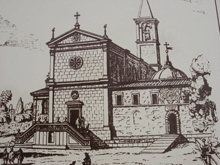Tombs of the Irish Earls: Burials in Rome

 The church San Pietro in Montorio in Rome is linked to one of the major turning points in the history of Ireland - the episode known as the “Flight of the Earls” in the seventeenth century. The ancient church contains many treasures and has one of the best frescoes in Rome outside the Vatican. It is also the burial place of the Ulster Earls who sailed from Rathmullan, Co. Donegal in 1607, and died in exile in Rome.
The church San Pietro in Montorio in Rome is linked to one of the major turning points in the history of Ireland - the episode known as the “Flight of the Earls” in the seventeenth century. The ancient church contains many treasures and has one of the best frescoes in Rome outside the Vatican. It is also the burial place of the Ulster Earls who sailed from Rathmullan, Co. Donegal in 1607, and died in exile in Rome.
The “Flight of the Earls” was a watershed in Irish history, ushering in the end of the ancient Gaelic power-system, and the thorough British conquest of the island, which lasted until the establishment of an independent Irish state in 1921. It also opened the way for an intensive British colonisation of the Earls’ former territories in Ulster, leading eventually to the formation of Northern Ireland; this colonisation created frictions between the two traditions which, it is hoped, have now been overcome four hundred years after the Flight, by the success of the Irish peace process.

Flight of the Earls
In the sixteenth century, under the Tudor monarchs, the British Crown made sustained efforts to bring Ireland under their direct administrative control, and to extend the Protestant reformation to an Irish population which remained predominantly committed to the Church of Rome. These policies led to a bitter struggle between the forces of the British Crown and representatives of the older Irish dynasties, whose political system and pastoral traditions reached back to the Celtic Iron Age.
The main leaders on the Irish side in this “Nine Years War” were Hugh O’Neill, Earl of Tyrone, whose lands encompassed much of what is now Northern Ireland, and Hugh O’Donnell, Earl of Tir Connaill (Donegal). O’Neill proved an able general and inflicted significant defeats on the British forces. Increasingly seen as a champion of Catholicism, he was supported by an expeditionary force sent by King Philip of Spain to Ireland in 1601. The force landed in Kinsale, in the extreme south of Ireland, but the Ulster Chiefs’ attempts to support the Spaniards culminated in a decisive defeat for the Irish at the Battle of Kinsale.
An uneasy accommodation with the Crown followed, but the earls became increasingly convinced that their lives and property were fatally at risk. In September 1607 O’Neill and the chief representatives of the Ulster clans took ship secretly with about ninety followers, intending to raise an invasion force from the King of Spain. Blown off course, they landed in France and were eventually diverted to Rome as guests of the Pope. After his arrival in Rome in 1608 O’Neill remained tireless in his efforts to raise a new expeditionary force for Ireland. Spain however preferred to keep O’Neill in reserve as a potential asset against England rather than engage in open war on his behalf, and O’Neill died in Rome in 1616 with his objectives unfulfilled.
 Commemorative events
Commemorative events
In 2007 and 2008 major commemorative events of this watershed in Irish history have been held in Ireland and abroad. This year in Rome a conference took place on 12 April followed by a ceremony on 13 April at the church of San Pietro in Montorio where Hugh O’Neill, Earl of Tyrone, and Rory O’Donnell are buried. Accompanied by priests from the Irish College in Rome, a mass was celebrated by Cardinal Sean Brady in the presence of members of the Irish diplomatic service, representatives to the Holy See and others.
Among the congregation were the O’Neill family descendants from France, Germany, Portugal, Spain and Switzerland. During his homily, the Cardinal contrasted the antagonistic relationship between Ireland and Britain in 1608 with the situation today. He suggested that the European Union had played a large part in this transformation and in particular in bringing peace to the North of Ireland.
Tombs of the Irish Earls
O’Neill was laid to rest in San Pietro in Montorio. His simple tombstone disappeared in the nineteenth century. In the nave of the church a white marble floor plaque with cross is inscribed D.O.M. HUGONIS PRINCIPIS ONELLI OSSA. Alongside are two elaborately decorated and inscribed tombstones set into the floor of the Church, one commemorating Rory O’Donnell, Earl of Tyrconnell and his brother Cafarr, who died in 1608 and the other O’Neill’s eldest son, the Baron of Dungannon, who died in 1609.
 Ita Marguet, July 2008
Ita Marguet, July 2008
Note: Acknowledgement is given to all sources used in preparation of this text. It follows those entitled Flight of the Earls: Ireland and Switzerland (1607-1608), Flight of the Earls: A Bridge Between Ireland and Europe (Ita Marguet, 2008), and a visit to San Pietro in Montorio, May 2008.


